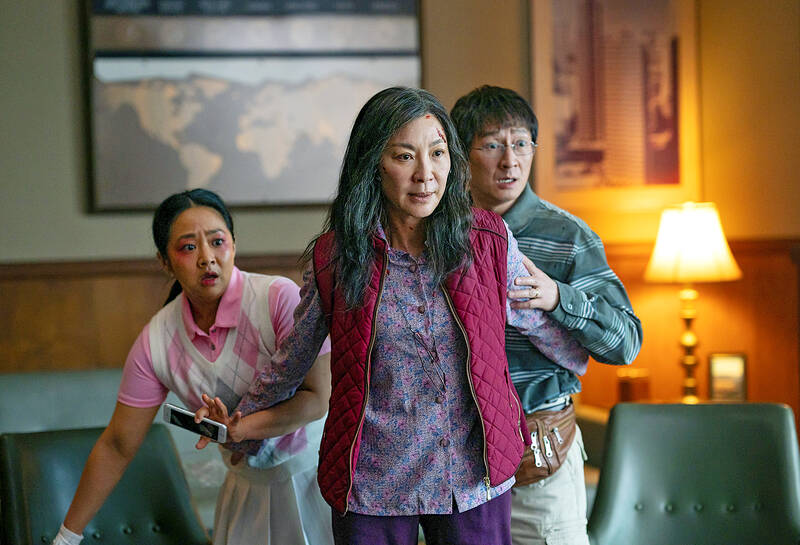It’s easy to forget, given the current glut of robot-uprising doom flicks, that Hollywood has been doing the artificial intelligence thing for decades — long before anything resembling true AI existed in the real world. And now we live in an era in which a chatbot can write a passable sonnet, it is perhaps surprising that there hasn’t been a huge shift in how film-makers approach this particular corner of sci-fi.
Gareth Edwards’ The Creator (2023) is essentially the same story about AIs being the newly persecuted underclass as 1962’s The Creation of the Humanoids, except that the former has an US$80 million VFX budget and robot monks while the latter has community-theater production values. Moon (2009) and 1968’s 2001: A Space Odyssey are both about the anxiety of being trapped with a soft-voiced machine that knows more than you. Her (2013) is basically Electric Dreams (1984) with fewer synth-pop arpeggios.
No one is suggesting Hollywood should start making films about what AI actually does. It seems unlikely that film-goers would flood to multiplexes to catch a three-act tech farce in which a nefarious algorithm admits it can’t answer the hero’s question because it “doesn’t have access to data yet.” But we should at least be getting something that feels like it’s been inspired by recent developments, rather than expensively produced and lavishly recycled takes on stories we’ve all seen before.

Photo: AP
From the look of its debut trailer, Gore Verbinski’s Good Luck, Have Fun, Don’t Die may not be the bold reinvention of AI cinema we might want, but it is at least gesturing towards something new. This time, the AI in question doesn’t seem hugely interested in saving or destroying mankind; instead it’s acting like a chaotic, reality-bending dungeon master, running humans through a cosmic escape room for reasons that make sense only to itself. Could machines of the future have taken a note from modern day YouTubers who spend all day and night livestreaming their own digital reality? Is this all just a great big laugh at the expense of humanity by a god-like deity?
Perhaps this is more about the Deadpoolisation of modern blockbuster cinema, but the sense I get from this trailer is that Hollywood has finally run out of ways to make AI frightening, wise or soulful, and has decided to make it an endlessly glitched-out nonsense engine instead.
A jittery man from the future (Sam Rockwell) bursts into a diner to inform a random assortment of strangers that they must help him prevent the AI apocalypse. Suddenly we’re pinballing between spider-legged dollbots, neon-lit dystopian alleyways and what looks like a giant ungulate striding through suburbia, all intercut with quippy one-liners from people who seem to want to narrate their own AI apocalypse in real time. Mystical triangular glyphs are everywhere and set-pieces arrive with the panicked rhythm of a timeline that’s clearly being reloaded every 30 seconds.
There’s a definite hint of Everything Everywhere All At Once in the over-caffeinated speed-cutting chaos too, but at least we’re not being handed yet another ponderous parable about robot souls, digital enlightenment or the hubris of man. Verbinski’s film also stars Juno Temple and Haley Lu Richardson and is out in February, when we’ll presumably find out what unholy combination of prompts caused the timeline to glitch this badly in the first place.

Last week gave us the droll little comedy of People’s Republic of China’s (PRC) consul general in Osaka posting a threat on X in response to Japanese Prime Minister Sanae Takaichi saying to the Diet that a Chinese attack on Taiwan may be an “existential threat” to Japan. That would allow Japanese Self Defence Forces to respond militarily. The PRC representative then said that if a “filthy neck sticks itself in uninvited, we will cut it off without a moment’s hesitation. Are you prepared for that?” This was widely, and probably deliberately, construed as a threat to behead Takaichi, though it

Nov. 17 to Nov. 23 When Kanori Ino surveyed Taipei’s Indigenous settlements in 1896, he found a culture that was fading. Although there was still a “clear line of distinction” between the Ketagalan people and the neighboring Han settlers that had been arriving over the previous 200 years, the former had largely adopted the customs and language of the latter. “Fortunately, some elders still remember their past customs and language. But if we do not hurry and record them now, future researchers will have nothing left but to weep amid the ruins of Indigenous settlements,” he wrote in the Journal of

Even after years in business, weekend tables here can be booked out a month in advance. The price point far exceeds its competitors. Granted, expectations are soaringly high, but something here failed to hit the high notes. There are a few telltale signs that a restaurant relies solely on outstanding food to create the experience, no gimmicks or distractions needed. La Mole is such a restaurant. The atmosphere is food-forward, with an open kitchen center stage. Our tables are simple; no candles, no dim lighting, no ambient music. The menu is brief, and our waiter directs most

If China attacks, will Taiwanese be willing to fight? Analysts of certain types obsess over questions like this, especially military analysts and those with an ax to grind as to whether Taiwan is worth defending, or should be cut loose to appease Beijing. Fellow columnist Michael Turton in “Notes from Central Taiwan: Willing to fight for the homeland” (Nov. 6, page 12) provides a superb analysis of this topic, how it is used and manipulated to political ends and what the underlying data shows. The problem is that most analysis is centered around polling data, which as Turton observes, “many of these